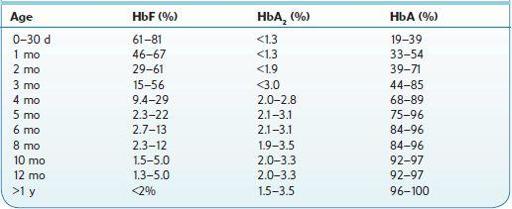Wallach's Interpretation of Diagnostic Tests: Pathways to Arriving at a Clinical Diagnosis (975 page)
Authors: Mary A. Williamson Mt(ascp) Phd,L. Michael Snyder Md

BOOK: Wallach's Interpretation of Diagnostic Tests: Pathways to Arriving at a Clinical Diagnosis
7.22Mb size Format: txt, pdf, ePub
Decreased In
Hb is reduced in all anemias, in most cases as a consequence of another underlying disease or a deficiency (iron, folate, vitamin B
12
).
Increased In
Hb is higher as a physiologic response to high altitude due to low oxygen tension or in advanced lung or cardiac disease.
Certain myeloproliferative neoplasms, especially polycythemia vera, present with inappropriate elevation of Hb.
HEMOGLOBIN (Hb) VARIANT ANALYSIS
*
Definition
Hb variant analysis is a separation process used to identify normal and abnormal forms of Hb. HbA is the main form of Hb in the normal adult. HbF (fetal) is the major Hb in the fetus, and the remainder is HbA
2
. Approximately 800 mutant forms of hemoglobin have been identified. Some are asymptomatic, especially in heterozygotes. Some may cause major morbid effects, especially in homozygotes. Globins found in different hemoglobins during fetal and adult life are indicated by Greek characters: α, β, γ, and δ. Variations in the amino acid composition of the globin chains cause the hemoglobinopathies.

Normal range:
In healthy adults, 95–98% of the total Hb is HbA (α2 β2), 2–3% is HbA
2
(α2 δ2), and 0.8–2.0% is fetal Hb (HbF) (α2 γ2). Note that the reference range is different in individuals younger than age 1. See Table 16.39.
TABLE 16–39. Normal Values for Hemoglobin Variants by Age

Use
Evaluate a positive sickle cell screening test to differentiate sickle cell trait from sickle cell disease.
Once there is a high clinical suspicion and the preliminary hematologic and genetic information point toward a hemoglobinopathy, an investigation for definitive diagnosis of an abnormal Hb is warranted. Such a diagnosis will
Assist in the diagnosis of thalassemia, especially in patients with a family history positive for the disorder
Evaluate Coombs negative hemolytic anemia of unknown etiology
Other books
Ethan Frome, Summer, Bunner Sisters by Edith Wharton
Little Brats: Fiona: Forbidden Taboo Erotica by Selena Kitt
Into the Fire by Ashelyn Drake
Wolf's-own: Weregild by Carole Cummings
The Unwilling Apprentice (Book 2) by Heidi Willard
Oathkeeper by J.F. Lewis
[02] Elite: Nemorensis by Simon Spurrier
The Dark Knight by Elizabeth Elliott
The Imposter Bride by Nancy Richler
Breaking Through (The Breaking Series Book 3) by Juliana Haygert